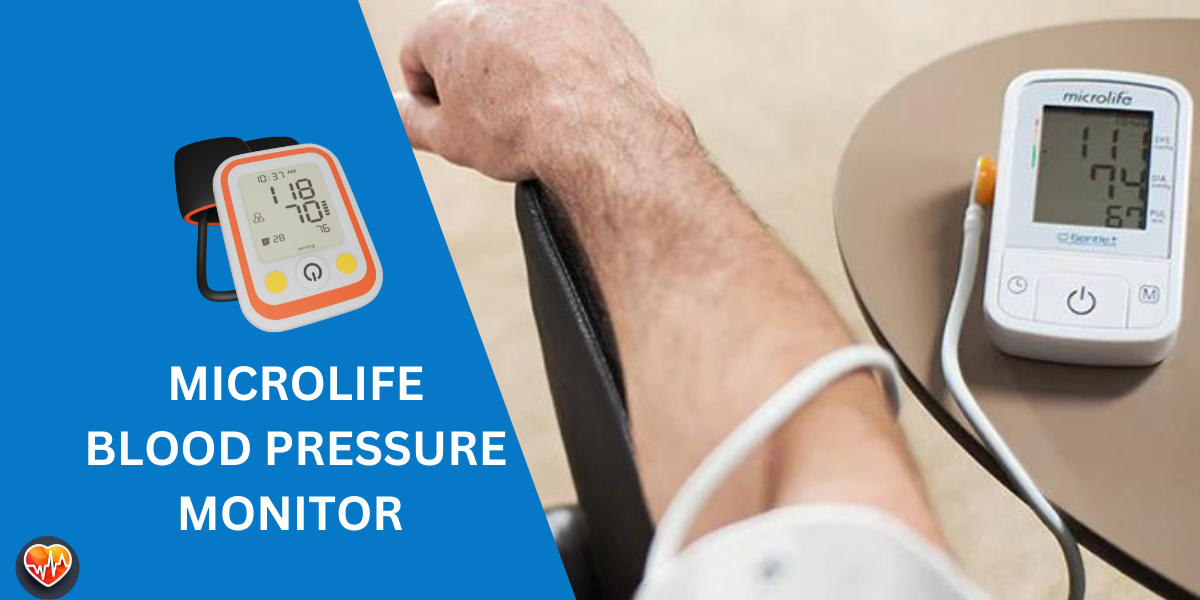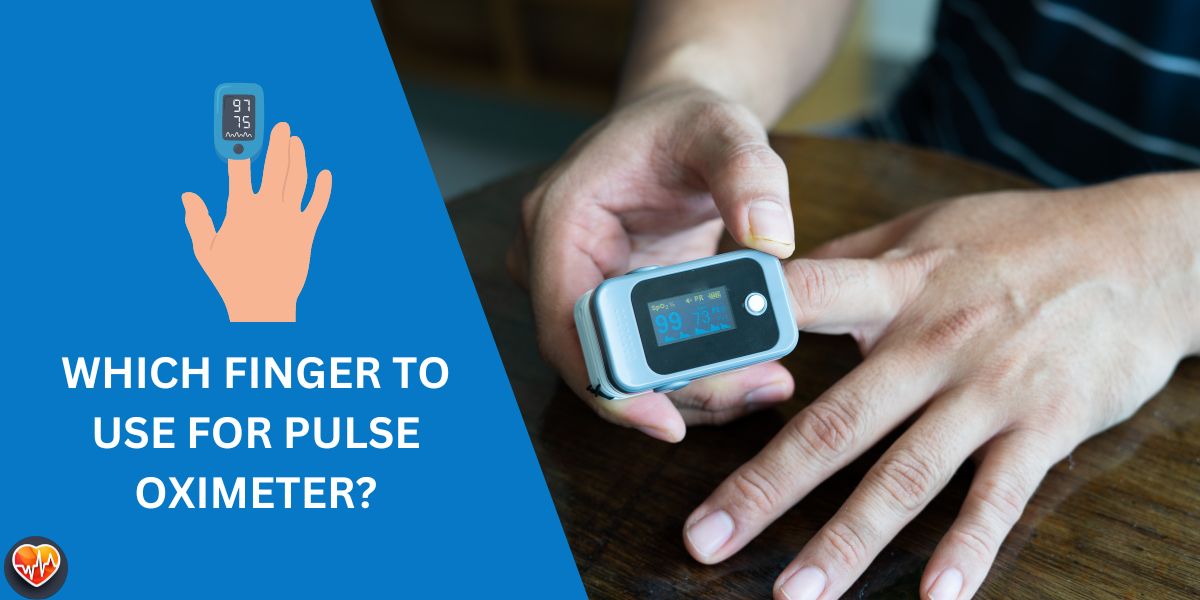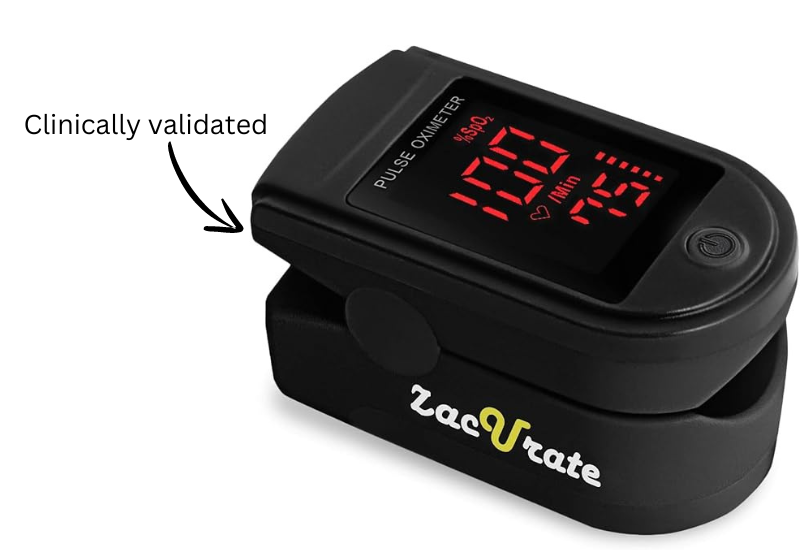
Clinically validated with ±2% accuracy, this pulse oximeter boasts a large LED display, 40+ hour battery life, and a 2-year warranty.

Affordable and reliable, this FDA-approved pulse oximeter offers basic functionality and a 30-hour battery life.

Track your vitals with this Bluetooth-enabled pulse oximeter, featuring unlimited data storage, customizable alarms, and 16-hour battery life.

Are you feeling a little short of breath? Curious about that little number everyone’s been talking about – your blood oxygen level?
A pulse oximeter can give you the answers, but choosing the right one can be challenging.
We’ve researched for you, narrowing it down to the seven best pulse oximeters for accuracy and ease of use in 2024. Let’s find the perfect one to help you breathe easier.
What is the Best Pulse Oximeter?
The “best” pulse oximeter really depends on your individual needs and budget.
Some prioritize accuracy above all else, while others may prefer a device with extra features like Bluetooth connectivity or a larger display. But don’t worry, we’ve got you covered.
Below, we’ve handpicked 7 pulse oximeters that excel in accuracy, ease of use, and overall value, catering to a range of preferences.
1. Zacurate Pro Series 500DL
The Zacurate Pro Series 500DL is like the trusty workhorse of pulse oximeters. It’s reliable, straightforward, and gets the job done without any fuss. No fancy bells and whistles here, just accurate readings you can count on.

Our Take
The Zacurate Pro Series 500DL is a top-notch pulse oximeter that delivers accurate readings without breaking the bank. It’s a great choice for anyone who prioritizes accuracy, simplicity, and value. The only reason it doesn’t get a perfect 10 is the need for extra features, but for the price, it’s hard to beat.
Key Benefits
- Accuracy: Clinically validated with ±2% accuracy for SpO2 and ±2 bpm for pulse rate.
- Ease of Use: One-button operation; even your grandma can figure it out.
- Display: Large, bright LED display that’s easy to read from any angle.
- Features: Plethysmograph (waveform) and bar graph display for visual feedback.
- Comfort: Soft silicone finger chamber fits snugly without pinching.
- Battery Life: 40+ hours of continuous use with two AAA batteries.
- Warranty: 2-year warranty and lifetime support from Zacurate.
Pricing
- Price: Starting at $22.99
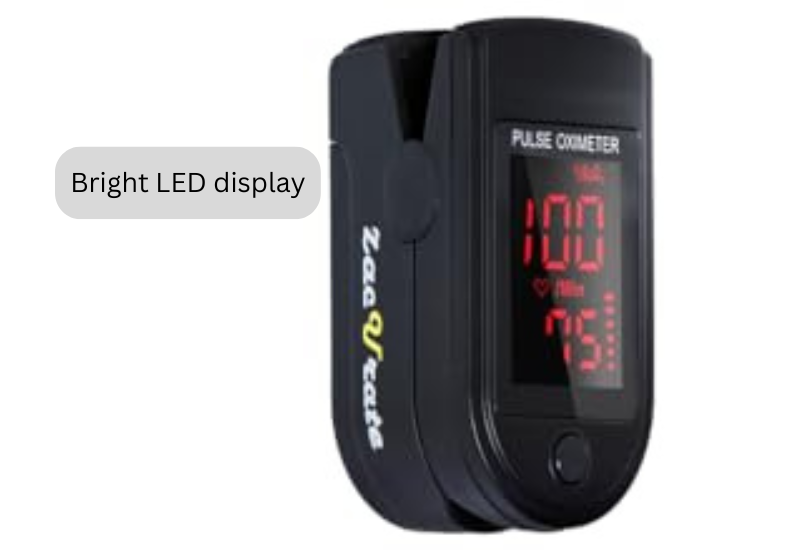
Pros
Cons
2. Innovo Deluxe iP900AP
The Innovo Deluxe iP900AP is the tech-savvy cousin of the Zacurate. It still boasts high accuracy, but it adds a few extra features that data enthusiasts will appreciate.
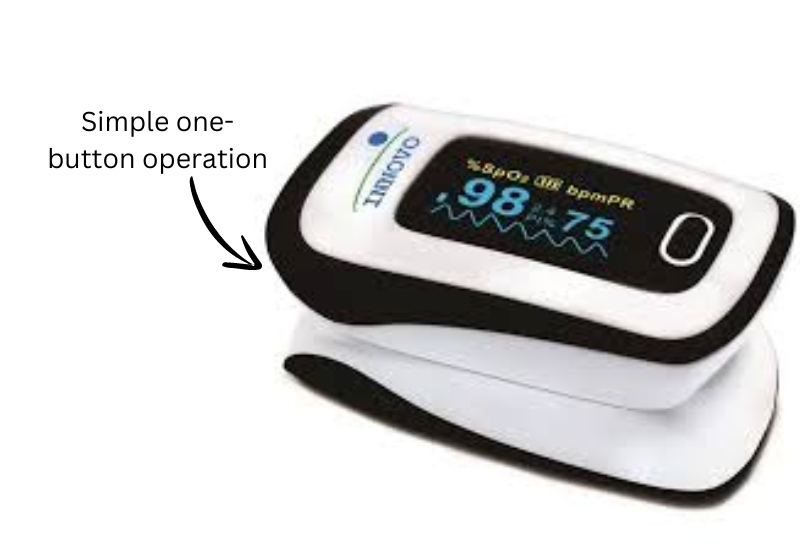
Our Take
The Innovo Deluxe iP900AP is a solid choice for those who want a bit more data and functionality from their pulse oximeter. It offers good value for the price, although the learning bend might be a bit steeper than for the Zacurate.
Key Benefits
- Accuracy: Clinically tested with ±2% accuracy for SpO2 and ±2 bpm for pulse rate.
- Ease of Use: Simple one-button operation, but also includes menu navigation for extra features.
- Display: Bright OLED display with six different display modes for customizable viewing.
- Features: Alarm function for high/low SpO2 and pulse rate, plethysmograph and perfusion index readings, and a memory function to store up to 10 readings.
- Comfort: Comfortable silicone finger chamber with a spring system for a secure fit.
- Battery Life: 20+ hours of continuous use with two AAA batteries.
Pricing
- Price: starting at:$34.99

Pros
Cons
3. Online Pulse XS-Pro
The Oxiline Pulse XS Pro is the stylish and compact option, perfect for those who want a discreet and portable pulse oximeter.

Our Take
The Oxiline Pulse XS Pro is a great option for those who prioritize portability and style. It’s accurate and easy to use, but the smaller display might not be ideal for everyone.
Key Benefits
- Accuracy: Meets international standards for accuracy (ISO 80601-2-61:2017).
- Ease of Use: One-button operation with automatic power-off.
- Display: Bright OLED display with four display modes.
- Features: Alarm function for low SpO2 and pulse rate, plethysmograph waveform display.
- Comfort: Compact and lightweight design, fits easily in a pocket or purse.
- Battery Life: Up to 24 hours of continuous use with two AAA batteries.
Pricing
- Price: starting at:$12.95

Pros
Cons
4. Wellue
The Wellue Bluetooth Fingertip Pulse Oximeter is the data-driven choice, allowing you to track your oxygen levels and heart rate over time with its smartphone app.

Our Take
The Wellue Bluetooth Fingertip Pulse Oximeter is a fantastic option for those who want to track their health data over time. It’s accurate, easy to use, and offers a range of features through its app. However, it is a bit pricier than other models.
Key Benefits
- Accuracy: Meets international standards for accuracy.
- Ease of Use: One-button operation, easy pairing with the ViHealth app.
- Display: Bright OLED display with four display modes.
- Features: Bluetooth connectivity for data tracking and sharing, customizable alarms, and unlimited data storage on the app.
- Comfort: Ergonomic design for comfortable use.
- Battery Life: Up to 16 hours of continuous use.
Pricing
- Price: starting at:$19.99
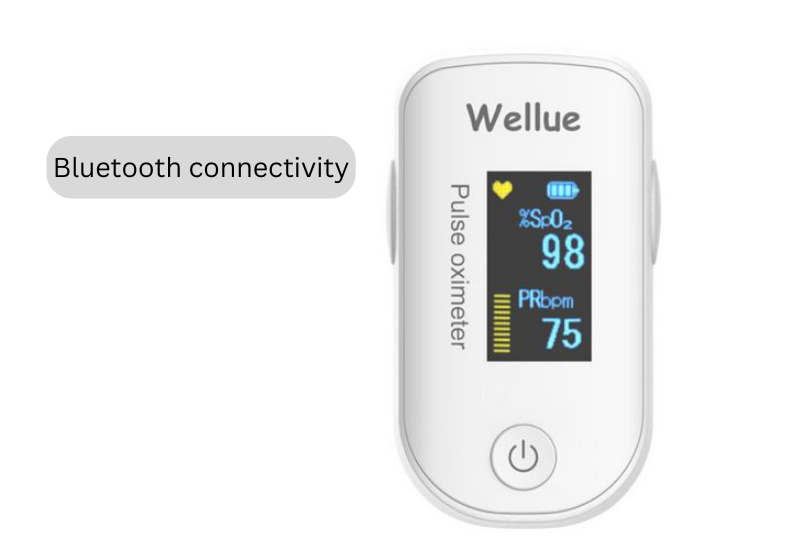
Pros
Cons
5. Zacurate 500E
The Zacurate 500E is the upgraded sibling of the Pro Series 500DL. It maintains the same accuracy but adds a splash of color and a few bonus features.

Our Take
The Zacurate 500E is a fantastic value for the price, offering all the essentials you need in a pulse oximeter with some added flair. It’s a solid choice for those who prioritize accuracy, ease of use, and affordability.
Key Benefits
- Accuracy: Clinically validated with ±2% accuracy for SpO2 and ±2 bpm for pulse rate.
- Ease of Use: One-button operation with automatic shut-off.
- Display: Large LED display with six different display modes and 10 brightness levels.
- Features: Plethysmograph (waveform) and bar graph display, audible alarm for low readings, and low battery indicator.
- Comfort: Soft silicone finger chamber for a comfortable fit.
- Battery Life: 40+ hours of continuous use with two AAA batteries.
- Warranty: 2-year warranty and lifetime support from Zacurate.
Pricing
- Price: starting at:$29.99

Pros
Cons
6. SantaMedical
The SantaMedical Finger Pulse Oximeter is a budget-friendly option that still delivers accurate readings. It’s a no-frills device that gets the job done.

Our Take
The SantaMedical Finger Pulse Oximeter is a good choice for those on a tight budget. It offers decent accuracy and ease of use, but lacks some of the additional features found in more expensive models.
Key Benefits
- Accuracy: Meets FDA and CE standards for accuracy.
- Ease of Use: One-button operation with automatic power-off.
- Display: Bright LED display with four display modes.
- Features: Low battery indicator.
- Comfort: Lightweight and compact design.
- Battery Life: Up to 30 hours of continuous use with two AAA batteries.
Pricing
- Price: starting at:$24.95

Pros
Cons
7. Zacurate Digital Pediatric
The Zacurate Digital Pediatric Finger Pulse Oximeter is specially designed for children, with a smaller finger chamber and fun animal designs.
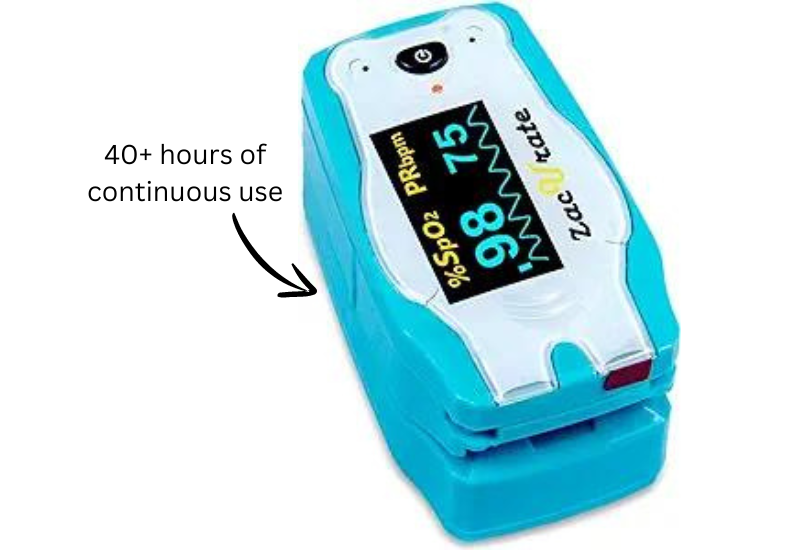
Our Take
The Zacurate Digital Pediatric Finger Pulse Oximeter is a reliable and fun choice for monitoring your child’s oxygen levels. It’s accurate, easy to use, and comes with a variation of fun designs that kids will love.
Key Benefits
- Accuracy: Clinically validated for use in children.
- Ease of Use: One-button operation with automatic shut-off.
- Display: Bright LED display with six different display modes.
- Features: Plethysmograph (waveform) and bar graph display.
- Comfort: Small finger chamber designed for children’s fingers.
- Battery Life: 40+ hours of continuous use with two AAA batteries.
- Warranty: 2-year warranty and lifetime support from Zacurate.
Pricing
- Price: starting at:$29.99

Pros
Cons
What to Look for When Buying a Pulse Oximeter?
- Accuracy: This is the most crucial factor. Look for devices that are FDA-approved and clinically validated.
- Ease of Use: The device should be intuitive, with a clear display and easy-to-understand readings.
- Display: A bright, easy-to-read display is essential, especially in low-light conditions. Consider displays that can be viewed from multiple angles.
- Features: Some pulse oximeters offer additional features like Bluetooth connectivity for data tracking, alarms for low readings, and the ability to store multiple readings. Decide which features are important to you.
- Comfort: If you plan on using the pulse oximeter for extended periods, comfort is key. Look for models with adjustable grips and soft finger pads.
- Battery Life: Consider how often you’ll be using the device and choose a model with a battery life that suits your needs.
- Price: Pulse oximeters range in price, so set a budget and look for the best value within that range.
- Warranty: A good warranty can give you peace of mind in case of any issues with the device.
Benefits of Pulse Oximeter?
A pulse oximeter is a easy to use device that can give you a quick and painless measurement of your oxygen saturation.

Oxygen saturation, also known as blood oxygen saturation or SpO2, refers to the percentage of oxygen carried by your red blood cells.
This is an important health metric because oxygen is essential for all bodily functions.
While a pulse oximeter reading can’t replace a more precise medical test like an arterial blood gas test, it can provide valuable information for people with certain health conditions, such as chronic obstructive pulmonary disease (COPD) or asthma.
It can also be helpful for people who are at high risk of complications from COVID-19, athletes monitoring their performance, or anyone who simply wants to keep tabs on their in general health.
By regularly monitoring your blood oxygen levels with a pulse oximeter, you can detect early signs of hypoxia (low oxygen levels) and seek medical attention if needed.
Buyer’s Guide
When researching the best pulse oximeters, we delved deep into the world of pulse oximetry, focusing on how these devices use infrared light to measure blood oxygen levels.

Our goal was to find devices that delivered accurate readings, even compared to the gold standard of arterial blood gas tests.
We also wanted to make sure the options we chose were user-friendly, even for those who have never used a pulse oximeter before and don’t know what a normal pulse oximeter reading looks like.
Here’s a breakdown of our research process:
- Accuracy: We prioritized pulse oximeters that were FDA-approved and clinically validated to ensure reliable readings.
- Features: We looked for devices that offered a scope of features, from basic functionality to advanced options like Bluetooth connectivity and data tracking.
- Ease of Use: We tested each device to see how intuitive it was to operate, taking into account factors like display clarity, button placement, and overall user experience.
- Pricing: We compared prices across different brands and models to find the best value for your money.
- Support & Warranty: We investigated each company’s customer support options and warranty policies to ensure you’re covered in case of any issues.
- Reviews: We scoured online reviews from both experts and users to get a well-rounded perspective on each product’s performance and reliability.
By considering all these factors, we’ve compiled a list of the 7 best pulse oximeters that excel in accuracy, ease of use, and overall value, catering to a variety of needs and budgets.
Wrapping Up
Choosing the right pulse oximeter is essential for accurately monitoring your blood oxygen saturation levels.

With a variety of finger pulse oximeters and at-home pulse oximeters available, it’s important to consider factors like accuracy, ease of use, and features. Remember, pulse oximetry relies on infrared light to measure blood oxygen levels by analyzing how much light is absorbed by the red blood cells in your finger.
While a normal pulse oximeter reading typically falls between 95% and 100%, it’s crucial to consult with your doctor if you have concerns about your blood oxygen saturation levels, especially if you have underlying health conditions.
We’ve done the research for you, highlighting top-rated options like the Zacurate Pro Series 500DL and the Innovo Deluxe iP900AP, as well as other notable models like the Contec pulse oximeter. By understanding the features and benefits of different pulse oximeters, you can make an informed decision and find the perfect device to esemble your needs.
Frequently Asked Questions
What are normal pulse oximeter readings?
A normal pulse oximeter reading (SpO2) usually ranges between 95% and 100%. Readings below 95% may indicate low oxygen levels and warrant medical attention.
Does a pulse oximeter measure blood pressure?
No, a pulse oximeter measures blood oxygen saturation (SpO2) and pulse rate, not blood pressure. You’ll need a separate device, like a blood pressure monitor, to measure your blood pressure.
Are pulse oximeters accurate?
Yes, when used correctly, pulse oximeters can provide accurate readings. However, factors like movement, poor circulation, or nail polish can affect accuracy. Choose an FDA-approved pulse oximeter for reliable results.
Do I need a prescription for a pulse oximeter?
No, most pulse oximeters are available over-the-counter without a prescription. However, prescription pulse oximeters may be recommended for certain medical conditions or insurance coverage.
How often should I use a pulse oximeter?
The frequency of use depends on your health condition and doctor’s advice. For general health monitoring, occasional use may be sufficient. If you have a chronic condition like COPD or asthma, your doctor may recommend more frequent monitoring.




